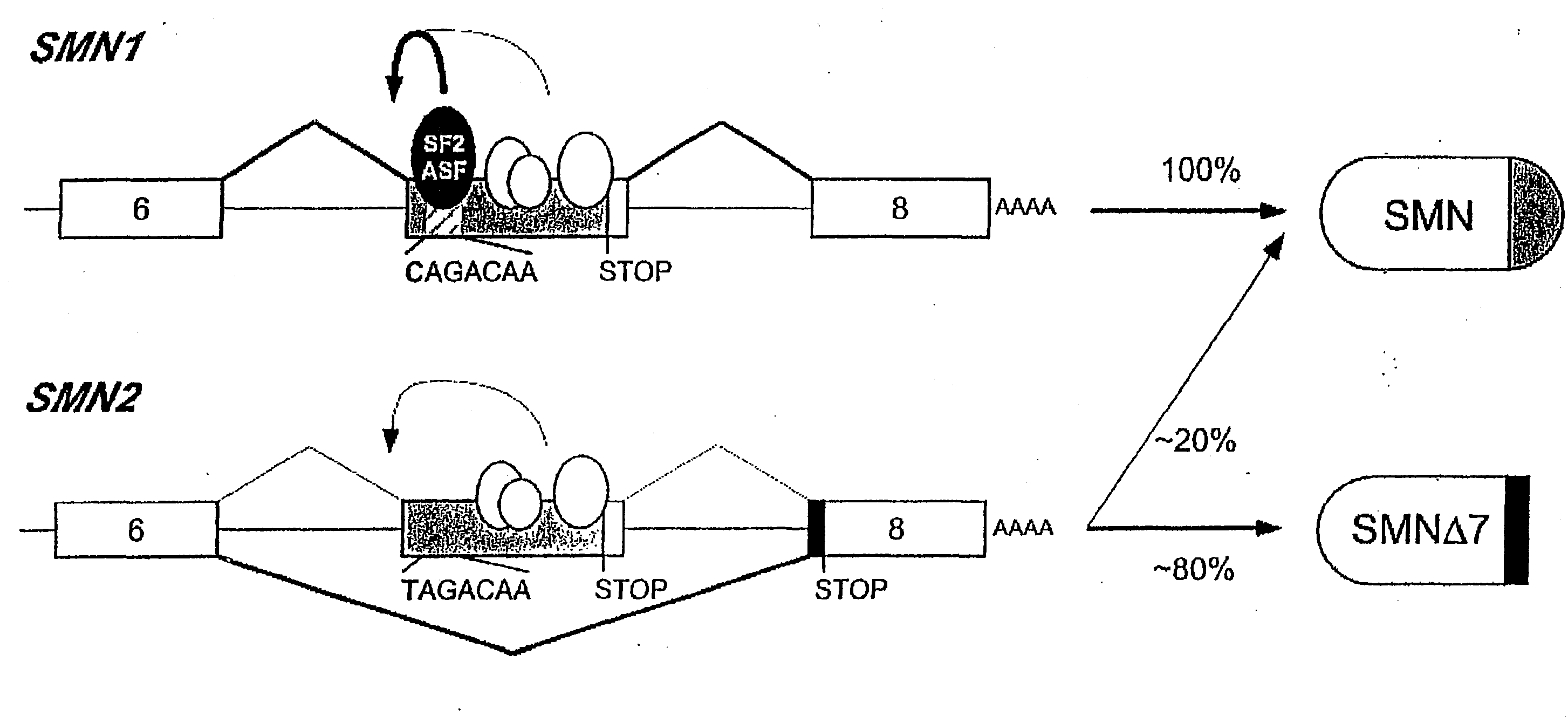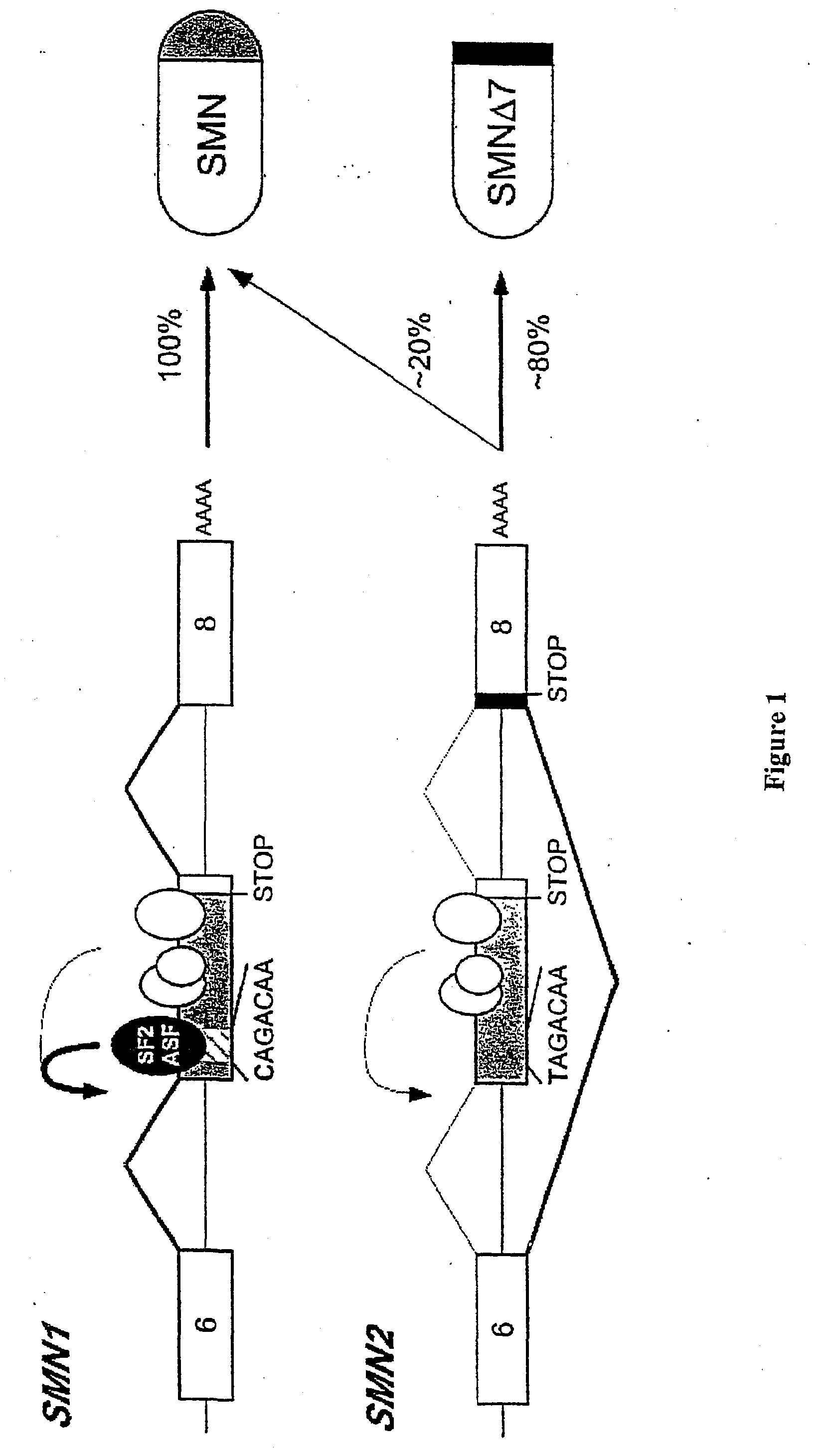Chimeric Molecules to Modulate Gene Expression
a technology of chimeric molecules and gene expression, applied in the direction of peptides/protein ingredients, genetic material ingredients, peptides/protein ingredients, etc., can solve the problems of insufficient protein production, insufficient binding of these polyamides, and inability to bind polyamides to double-stranded dna only,
- Summary
- Abstract
- Description
- Claims
- Application Information
AI Technical Summary
Problems solved by technology
Method used
Image
Examples
example 1
SR Protein Motifs
[0151]A functional SELEX strategy coupled with the S100 complementation assay was developed to define the role of SR proteins in constitutive splicing. By means of this strategy sequence motifs that act as functional enhancers in the presence of the cognate recombinant SR protein were defined. FIG. 3 shows the motifs that were found for four SR proteins, displaying each nucleotide with a size proportional to its frequency at that position of the consensus. Each consensus was derived from an alignment of ˜30 functional sequences selected by splicing in the presence of a single SR protein. The motifs are highly degenerate, probably reflecting evolutionary constraints on the presence of exonic splicing signals within a vast set of unrelated protein-coding segments. The degeneracy is also consistent with the RNA-binding properties of SR proteins, which exhibit significant sequence preferences, but nevertheless can bind reasonably tightly to very diverse RNA sequences. T...
example 2
Mechanism of Exon Skipping in the BRCA1 Gene
[0153]The recently derived SF2 / ASF, SC35, SRp40, and SRp55 motif-scoring matrices were used to analyze the wild-type and a particular familial mutation in exon 18 of BRCA1. Multiple high-score motifs for each type of ESE are distributed throughout this exon (FIG. 13). The mutation at position 6 specifically disrupts the first of three high-score SF2 / ASF motifs. To study the mechanism of exon skipping, wild-type and mutant minigenes were constructed. These minigenes include exons 17 through 19 and shortened versions of introns 17 and 18.
[0154]Radiolabeled transcripts from these minigenes were spliced in vitro (FIG. 14). The two pre-mRNAs were spliced in strikingly different ways: with wild-type pre-mRNA (WT), exon 18 was efficiently included (lane 1), whereas with mutant pre-mRNA (NT), exon 18 was predominantly skipped (lane 2). FIG. 4 shows the time course results of the in vitro splicing assay.
[0155]Although the extent of exon inclusion a...
example 3
Methods for Examples 1 and 2
[0158]BRCA1 DNA templates. A portion of the wild-type human BRCA1 gene was amplified by PCR from human genomic DNA (Promega) using primers T7P1 (5′-TAATACGACTCAC-TATAGGGAGATGCTCGTGTACAAGTTTGC) (SEQ ID NO.: 6.) and P6 (5′-AAGTACT-TACCTCATTCAGC) (SEQ ID NO.: 7.). The amplified DNA was then used as a template for three separate PCR amplifications to synthesize intron-truncated DNA fragments: the first PCR amplified exon 17 and the 5′ part of intron 17 using primers T7P1 and P2 (5′-TAAGAAGCTAAAGAGCCTCACTCATGTGGTTTTATGCAGC) (SEQ ID NO.: 8); the second PCR amplified the 3′ part of intron 17, exon 18, and the 5′ part of intron 18 using primer P3 (5′-TGAGGCTCTTTAGCTTCTTA) (SEQ ID NO.: 9.) and P4 (5′-AGATAGAGAGGTCAGCGATTTGCA-ATTCTGAGGTGTTAAA) (SEQ ID NO.: 10.); the third PCR amplified the 3′ part of intron 18 and exon 19 using primers P5 (5′-AATCGCTGACCTCTCTATCT) (SEQ ID NO.: 11) and P6. The three PCR products were then combined and amplified with primers T7P1 and...
PUM
| Property | Measurement | Unit |
|---|---|---|
| time | aaaaa | aaaaa |
| peptide-nucleic acid | aaaaa | aaaaa |
| branched structure | aaaaa | aaaaa |
Abstract
Description
Claims
Application Information
 Login to view more
Login to view more - R&D Engineer
- R&D Manager
- IP Professional
- Industry Leading Data Capabilities
- Powerful AI technology
- Patent DNA Extraction
Browse by: Latest US Patents, China's latest patents, Technical Efficacy Thesaurus, Application Domain, Technology Topic.
© 2024 PatSnap. All rights reserved.Legal|Privacy policy|Modern Slavery Act Transparency Statement|Sitemap



